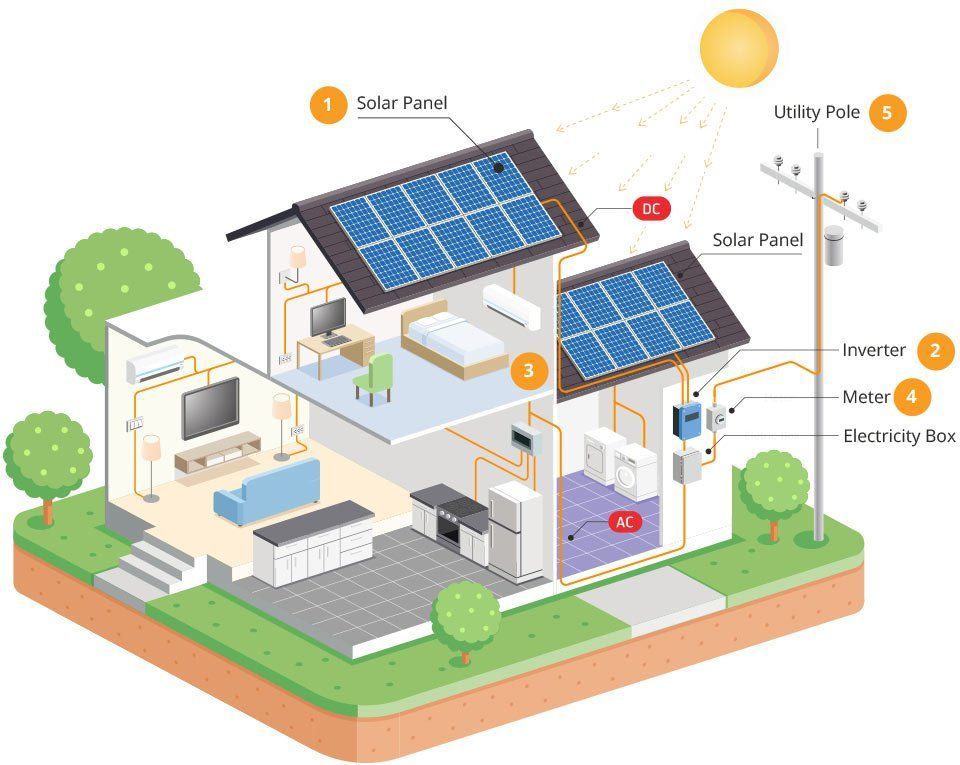How Solar Panels Work
What Is Solar Energy?
Solar photovoltaic (PV) systems, also known as solar electric systems, capture sunlight energy and convert it into electricity. PV systems can be used to power everything in your home from lights and appliances to an electric vehicle.
How does a Solar PV System work?
- Individual Photovoltaic (PV) Cells are connected to each other in a Solar Panel or Solar Module. Solar panels convert the energy from sunlight into direct current (DC) electricity.
- The DC electricity is delivered to the Inverter, which converts direct current (DC) electricity into alternating current (AC) electricity that we use in our homes and business. Most appliances and electrical gadgets run on AC electricity.
- If your home has a battery back up system some energy produced by your solar panels will be stored for use later. Instead of having to produce electricity at the exact time when you need it, batteries allow you to generate electricity at any time, providing flexibility for how you meet your demand with supply. Storing energy offers many benefits, from financial savings to backup power in a grid outage. There are two types of battery back up systems, AC coupled and DC coupled.
- The Utility Meter records the net amount of energy consumed by utility customers. When a solar customer produces more energy than they use during the day, the meter will "spin backward" and the excess electricity is sent to the electric grid. At the end of the month, the utility company bills the customer for the net amount of energy they purchased from the electric grid.
How Does Net Metering (NEM) Work?
Net metering is a billing mechanism that credits solar energy system owners for the electricity they add to the grid. For example, if a residential customer has a solar system on their roof, it will likely generate more electricity than the home uses during daylight hours. The extra electricity is "sold" to the utility in the form of a credit that is used to buy energy from the utility when needed.
Customers are only billed for their "net" energy use. The amount they receive as a credit depends on the net metering conditions offered by their utility.
How Is The Size Of Your Solar Panel System Estimated?
The size and power generation capabilities of your system is one of the most important factors in going solar. Too small and you will sacrifice or reduce your potential savings, too big and you will spend more money than you need and waist unused energy production. The average system size is between 5- 10 KW or 12 - 25 solar panels but there are several factors that impact the optimal system size for you.
- How much electricity did you use in the past 12 months?
- What are your future energy needs? Are you planning any of the following?
- Home improvements or additions to living space.
- Additions to your family or household size.
- Changes in your HVAC systems.
- New electric vehicles and charging stations.
- Swimming pools and or Hot tub additions.
- Additional energy efficient improvements that could reduce your electric energy needs.
- What is your desired bill and energy offset?
- How much usable space is available to install solar panels on your roof, yard or property for ground mount systems?
- What is your budget?
System Design
If you’re wondering how and where your solar panels get installed, typically, solar panels are installed on your roof and ideally you want to have as many panels facing South, Southwest, or Southeast as possible. In most cases, East, West, and even North-facing solar panels may produce enough power to improve the investment in solar.
If your roof is unsuitable or undesirable for solar panels, or if solar panels are discouraged by your Home Owner’s Association (HOA), a ground mounted system may be the right choice for you. Ground mounted solar systems can be more expensive to install, however the orientation and tilt can be maximized to achieve even faster breakeven timelines than roof mounted systems.
Also, if you do have an HOA, it’s good to know that your HOA may not stop you by law from installing solar or impose guidelines making it financially unfeasible.
Electricity or Solar?

